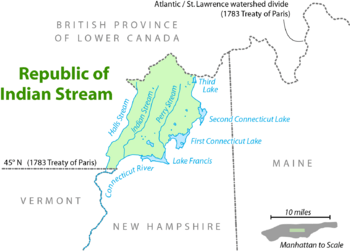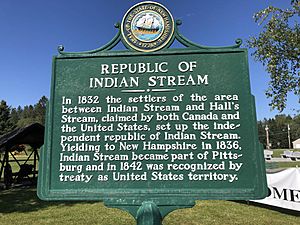Republic of Indian Stream facts for kids
Quick facts for kids
Republic of Indian Stream
|
|||||||||
|---|---|---|---|---|---|---|---|---|---|
| 1832–1835 | |||||||||

Location of the Republic of Indian Stream, bordered to the north by the British colony of Lower Canada and to the south by the American state of New Hampshire.
|
|||||||||
| Status | Unrecognized state | ||||||||
| Capital | Entire area later renamed Pittsburg, New Hampshire | ||||||||
| Largest city | N/A | ||||||||
| Common languages | English | ||||||||
| Government | Republic | ||||||||
| Justice of the Peace | |||||||||
|
• 1832−1835
|
Luther Parker | ||||||||
| Elected council | |||||||||
|
• 1835
|
Richard J. Blanchard, Jeremiah Tabor, Burley Blood, Abner Hyland, William White | ||||||||
| History | |||||||||
|
• Independence declared
|
July 9, 1832 | ||||||||
|
• Annexation by New Hampshire
|
August 5, 1835 | ||||||||
|
• Citizens resolution favoring New Hampshire
|
April 2, 1836 | ||||||||
|
• Independence relinquished
|
1835 | ||||||||
|
|||||||||
The Republic of Indian Stream was a small, independent country that no other nation officially recognized. It was located in North America, right on the border between what is now the Canadian province of Quebec and the U.S. state of New Hampshire. This unique republic existed for just over three years, from July 9, 1832, to August 5, 1835. It was sometimes called the "Indian Stream Territory" and was named after a small river in the area. Even though it was small, it had its own elected government and a constitution, serving about 300 citizens.
Contents
What Was Indian Stream?
The Republic of Indian Stream was a special kind of country. It was an "unrecognized state," meaning other larger countries didn't officially accept it as independent. It was a republic, which means its leaders were elected by the people, not born into power like kings or queens.
This small nation was formed because of a big problem: no one was sure which country it belonged to. Was it part of the United States or part of British Lower Canada? The people living there decided to create their own government until the bigger countries could sort things out.
Why Did Indian Stream Form?
The main reason Indian Stream became independent was a confusing border. After the American Revolutionary War, the 1783 Treaty of Paris was supposed to draw the line between the United States and British territory. However, the treaty's description of the border was unclear, especially around the top of the Connecticut River.
The treaty mentioned "the northwesternmost head of the Connecticut River." But there were three different rivers that could fit this description. Because of this confusion, both the United States (specifically New Hampshire) and British Canada (Lower Canada) claimed the same land.
The Problem of Double Taxation
This unclear border caused big problems for the people living in Indian Stream. Both the American and British governments sent their own tax collectors and sheriffs to the area. This meant people were being taxed twice and faced legal issues from two different governments.
The citizens were very unhappy about this. To solve the problem, they decided to take matters into their own hands. They formed their own government, hoping to create a stable place to live until the border dispute was settled.
How Did Indian Stream Govern Itself?
On July 9, 1832, the people of Indian Stream declared their independence. They wrote their own constitution, which was a set of rules for their government. One important person who helped write this constitution was Luther Parker. He served as the justice of the peace for the Republic from 1832 to 1835, acting as a judge and leader.
The constitution clearly stated their goal:
The people inhabiting the Territory formerly called Indian Stream Territory do hereby solemnly and mutually agree with each other to form themselves into a body politic by the name of Indian Stream and in that capacity to exercise all the powers of a free, sovereign and independent state, so far as it relates to our own internal Government till such time as we can ascertain to what government we properly belong.
This means they wanted to be a free and independent state, but only for their own local matters, until they knew which larger country they truly belonged to.
The End of the Republic
Even after Indian Stream declared independence, the sheriff from Coös County, New Hampshire still tried to get involved in their affairs. This led to a tense situation.
New Hampshire's Actions
In July 1835, the New Hampshire sheriff asked for the state's army, called the New Hampshire Militia. Two groups of soldiers gathered, ready to march into Indian Stream. The sheriff went ahead of them and met with the leaders of Indian Stream on August 4. He gave them an ultimatum, which is a final demand.
Faced with the threat of being taken over by force, most of the Indian Stream leaders agreed to become part of New Hampshire. The Republic stopped being independent the very next day, on August 5, 1835. Five of Indian Stream's leaders wrote to a British official, explaining that since they hadn't received protection from the British in time, they had agreed to join New Hampshire. One of their leaders, Richard I. Blanchard, even became a deputy sheriff for New Hampshire. The militia then went home.

A Diplomatic Incident
Joining New Hampshire didn't immediately solve all the problems. British officials were not happy about New Hampshire taking over. A small event soon made things worse.
In October 1835, Richard Blanchard, now a New Hampshire deputy, tried to arrest a man named John Tyler for an unpaid debt. Tyler was freed by his neighbors. When reporting the incident, Tyler falsely told a British judge that he was arrested in British territory. This led the British judge to issue an arrest warrant for Blanchard.
Blanchard was arrested by a British deputy and some people from Indian Stream who supported the British side. But on their way to Canada, a group of Indian Stream citizens stopped them, rescued Blanchard, and brought him back to Indian Stream.
Later, a group of armed Indian Streamers, who were very excited, caused more trouble. They shot the British deputy in the leg and captured the British judge, hitting him on the head. They took the bleeding judge to Canaan, Vermont, where local leaders treated his wound and quickly released him. After this, about 50 New Hampshire militia members occupied Indian Stream for several months.
On April 2, 1836, the citizens of Indian Stream officially agreed that "New Hampshire has a right to exercise an unconditional control over the territory of Indian Stream."
Averting War
This incident became a serious "diplomatic crisis" between the United States and Great Britain. The British ambassador complained to U.S. President Andrew Jackson. Both governments were worried that such a small issue could lead to a bigger conflict. They decided to work together to prevent the situation from getting worse. An uneasy peace lasted for several years.
In 1837, a British official named Lord Palmerston dropped all legal charges related to the incident. He still stated that the British believed the territory was theirs.
Indian Stream Becomes Pittsburg
Even in 1840, the area was still called Indian Stream in the U.S. census, with a population of 315 people. However, the residents asked to officially become a town. In 1840, the area was incorporated as the town of Pittsburg, New Hampshire.
Finally, in 1842, the long-standing land dispute was officially resolved by the Webster–Ashburton Treaty. This treaty clearly assigned the land to New Hampshire, ending the border confusion once and for all.

